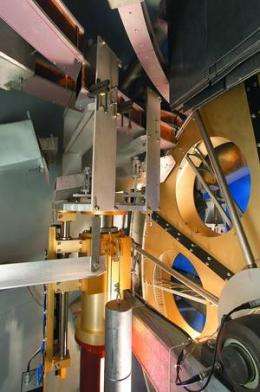Dark matter and string theory?

Super-cold neutrons could provide the answer. A new technique developed by neutron scientists is so sensitive that it could be used to measure the quantum effects of gravity. Minute deviations from Newtonian laws could prove whether dark matter or string theory’s extra dimensions exist.
Particle physicists from the Vienna University of Technology and Institut Laue-Langevin (ILL) have developed a new technique named Gravity Resonance Spectroscopy that bounces ultra-cold neutrons along a mirror to observe their various quantum energy states. By vibrating the mirror at particular frequencies, researchers are able to boost the neutrons to higher quantum energy states.
This is the first resonance-spectroscopy method, which does not use electromagnetic forces, fields or potentials to drive the transitions. Their success is an important step towards modelling gravitational interactions at very short distances and looking for predicted tiny deviations from pure Newtonian gravity.
The research, reported in Nature Physics, could also test the equivalence principle, a 16th century law that states gravity accelerates all objects equally, regardless of their mass. In 1971, it was famously demonstrated on the moon by Apollo astronaut Dave Scott who dropped a hammer and feather, which millions watching at home saw land simultaneously. Researchers hope to use this new technique to test the principle’s accuracy at the atomic level for the first time.
The visible effects of gravity are usually seen only at large scales, governing the motion of stars and planets whilst quantum mechanics is primarily evident at the atomic scale.
“In this tiny world, the gravitational force is so weak that it is difficult to observe its quantum effects,” explains Prof Hartmut Abele, from Vienna’s Institute of Atomic and Subatomic Physics. “Using atoms to measure these effects is extremely difficult as they are disturbed by short range electric forces such as Van der Waals or Casimir forces. However, using ILL’s ultra-cold neutrons, which are chargeless, very slow moving and extremely resistant to electrical disturbance we can measure these effects extremely precisely”.
Prof Abele, Tobias Jenke and scientists from ILL took a high precision spectroscopy technique measuring resonance, which is usually applied to electromagnetic interactions, and for the first time used it to measure gravity. Their work improves on research using ultra-cold neutrons and mirrors to observe quantum gravitation interactions, first devised at the world leading neutron facility in 2002. In this new research Prof Abele and his team mechanically induced transitions between these different energy states through the introduction of an oscillating field, achieved by vibrating the underlying mirror at a particular frequency. Using this technique future research will be able to calculate more precisely the energies behind the various quantum states of a neutron in the Earth's gravitational field.
Dr. Peter Geltenbort, Physicist at ILL and collaborator on this research: “In 2002, ultra-cold neutrons allowed us for the first time to observe the different quantum energy states of the neutron under the Earth’s gravity. Now with this technique we can attribute incredibly precise energies to each of these states. It’s a major breakthrough for those looking to understand the fundamental nature of gravity and bring together the physics of the atomic world with that of our own”.
Some physicists believe that more accurate measurement of these energies will reveal a slight divergence with those calculated using Newtonian laws of gravity. They predict that detecting and quantifying this disparity will provide evidence of dark matter particles known as axions or the extra dimensions suggested by string theory.
Prof Andrew Harrison, Science Director at ILL: “Whilst neutrons provide a valuable resource for applied science, Professor Abele’s research demonstrates their worth in uncovering the most basic truths in nature. Through our ongoing Millennium upgrade programme ILL continues to improve its capabilities to support world class fundamental and applied science.”
More information:
Nature Physics online, 17 April 2011
Provided by ILL Neutrons for Science